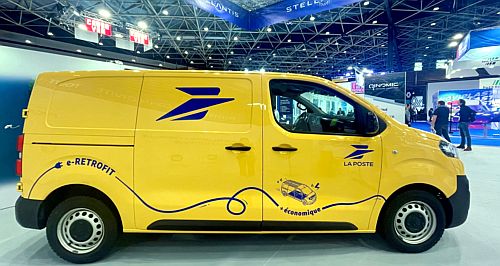Make / Model Search
News - General NewsLCVs prime for electrified second lifeElectric powertrain conversion specialists could offer ‘second life’ for used LCVs30 Jan 2024 THE viability of electric conversions for internal combustion engine (ICE) vehicles remains untenable for most road users, but that may soon change for commercial vehicle owners as businesses – including major car-makers – are getting in on the action.
A vehicle segment prime for ‘second life’ electric conversions is the light commercial sector, giving owners the opportunity to make the zero-emission switch while keeping existing vehicles – many of which are already expensively fitted out for specific uses.
Renault and Stellantis were the first manufacturers to confirm retrofit solutions for used vans in France, where there are government incentives that could cover up to 40 per cent of the conversion cost, transforming tired mid-size vans into zero-emission work vehicles ready for a second life.
Partnerships between Stellantis and Qinomic, and Renault and Tolv Systems, will see vans from Citroen, Fiat, Opel, Peugeot and Renault converted using retrofit packages that aim to improve the affordability of electric vans for small businesses.
These electric van conversions will be officially offered in France this year but apart from a handful of companies supplying electric-converted vehicles to the mining industry, there is no mention of plans to replicate a French-style second-life initiative in Australia.
While manufacturer-backed options remain out of reach for Australian business owners, a possible solution could be in aftermarket conversion specialists like Melbourne-based Jaunt Motors, which merged with British firm Zero EV in 2022 to form global electric conversion brand Fellten.
“We’ve had a lot of customer conversations because, let’s say you’ve fitted out a work van with 200-plus grand of equipment, and you’ve trained the personnel to use that equipment, suddenly a conversion can make much more sense in the short- to medium-term than a new vehicle and fit-out,” explained Jaunt Motors CEO Dave Budge.
“We can also tailor the high-voltage system to the needs of that vehicle, which is usually a bit different to what would already be available on the market.”
While companies like Jaunt Motors will convert just about any vehicle from internal combustion to electric power, it makes more sense for classic cars and off-roaders.
“The thing for us is that the investment you need to have all of the safety systems to offer a turnkey replacement for a new HiLux for example – that’s millions of dollars of development,” Mr Budge said.
“We’re full-up with conversions on vehicles like seven-seat Land Rover Defenders, up to the end of the classic model, and people are buying those as a family vehicle as an alternative to a new car, because you can’t buy an electric four-wheel drive right now.”
Whether a partnership like the Stellantis-Qinomic arrangement could work in Australia will depend on the requirements of owners, Mr Budge suggests.
“I think there is potential and I don’t think the scale has to be huge to make it viable, but there are so many market considerations like the distances Australians drive and the condition of our vehicles,” he said.
“You want to imagine a sort of drive-in, drive-out service for commercial vehicles where your fleet vehicles get dropped off and a week later you pick them up – I want to believe that it could happen, but it would need a manufacturer to back it.”
Another Australian electric conversion specialist, Mining Electric Vehicle Company (MEVCO), has opted to convert brand-new HiLux and LandCruiser models specifically for mining use with the help of local specialists SEA Electric and GB Auto, steering clear of used vehicle conversions altogether.
“For you to convert a diesel- or petrol-based vehicle from ICE to electric, you need to go through what they call a second stage of manufacturer (SSM) approval process,” explained MEVCO chief executive Matt Cahir.
“There’s a very difficult path to get to a fully registered electric vehicle if it’s not brand new.”
Mr Cahir says the regulatory hurdles serve an important purpose, preventing “backyard operators” from completing sub-par or unsafe conversions on used vehicles without proper testing.
“One thing I really stress about this is that there’s a lot of what I'd call ‘backyard operators; that haven’t gone through the testing processes,” he said.
“I would implore that anybody thinking about doing anything like this, that they look at the product, they look at the vendor that they're buying it from, and they understand that there's a lot of testing that's gone on behind it.
“Testing both at proving grounds and the chambers, and all the other places that a vehicle needs to be tested before we put a human in it.”
However, Mr Cahir does think second life conversions serve a purpose, allowing operators to transition their fleet, one-for-one, to electric, without simply adding vehicles into the mix.
“If you've got 10 vehicles and they're all running diesel, and you go and get battery electric vehicles, then you're typically increasing your fleet size to get battery electric vehicles – you’re not actually reducing your existing carbon footprint because you've still got the original 10 vehicles,” he said.
“So to be able to convert those 10 vehicles in your fleet to battery electric, you are actually really going after emissions so it makes a lot of sense.”
While Mevco does not produce vehicles for use outside of mining fleets, its road-registerable Toyota-based models have proven successful in mines across Australia, USA, Canada, Britain and Chile.
“Mining companies in a lot of respects are leading the world, in terms of going after carbon,” Mr Cahir said.
“I think this new era of electrification of fleets is really coming at speed.”
In the coming weeks, GoAuto will be able to share news of a dedicated electric vehicle MEVCO has trialled in Australian mine environments – so far only teased on the company’s LinkedIn page.
 Read more |
Click to shareGeneral News articlesResearch General News Motor industry news |












Facebook Twitter Instagram